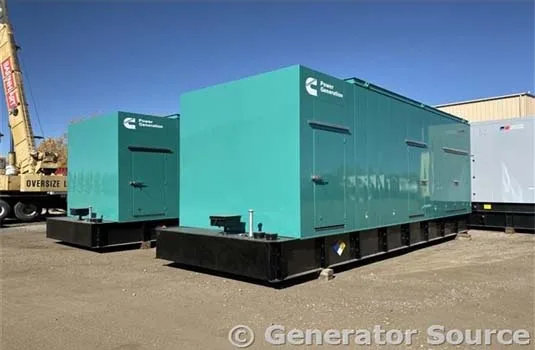
Industry Projections
Cummins 1500 kW Generators
When reviewing the generator industry, it is important to be aware that oftentimes the market is grouped in with electric motors. According to Global Industry Analysts, Inc., the electric motor and commercial generator industry is set to reach $73.2 billion dollars by 2015. The overall recovery cannot be attributed to one single factor in particular. Analysts speculate that development of new manufacturing lines, expansion of industrial infrastructure abroad, and an increase in shipping goods are all contributing to the growth of the power generation industry.
Recession’s Impact on the Industry
End-Use Applications for Generators
The most prevalent end-use applications for generators include industrial plants, manufacturing, construction, chemical applications, petrochemicals, agriculture, automotive, mining, oil and natural gas, telecommunication, and healthcare. The overall demand for energy is closely related to the level of economic activity.
Subsequently, the recession resulted in lower energy consumption levels across the board in the manufacturing, commercial, and construction industries. Reduced industrial activity directly corresponds to the decline of electric motor demand by end users. Electric motors are used heavily in industrial processing and are often powered by diesel generators.
Government Emission Regulations
Overview of Tiered Standards
The first wave of emission reduction standards for non-road diesel engines was introduced by the Environmental Protection Agency (EPA) in 1996. Non-road diesel engines could be classified as applications for construction or agriculture. The tiered program was implemented in 2007 and is to be phased in over a 4-year period ending in 2012.
Tier 4 Compliance and Phases
The tier rating structure (Tier 1-4; four being the strictest) is based upon the engine horsepower rating. The Tier system also regulates the amount of carbon monoxide, unburned hydrocarbons, and particulate matter produced from the engine.
The majority of non-emergency engines are required to be Tier 4 compliant by 2015. Emergency standby generators are exempt from new regulation as they usually are low-hour units that are only used when primary power goes out.
Grandfathering Older Engines
Used generators will be grandfathered in depending on state and local laws. Industry experts predict that older genset engines will be allowed to run out their normal life expectancy, while much older gensets may only have a market in other countries or be sold for scrap.

Increase in Global Demand
Energy Demand Trends
According to a comprehensive study by Exxon Mobile, global energy demand will be about 30% higher in 2040 than in 2010. This estimation is based upon the trend that economic production will more than double worldwide and the overall population will reach 9 billion people.
Regional Market Insights
The demand is strongest in Latin America, the Middle East, East Asia, and Africa due to rapid growth and unreliable electric grid networks. Most individuals and businesses in 3rd world nations use backup generating systems on a regular basis.
Fuel Source Trends
Fuel source trends are moving more towards natural gas, propane, kerosene, and compressed gas. Diesel fuel is still by far the most widely used fuel source, especially in developing nations; however, in the United States and Europe, more wind, solar, and biomass projects are being funded.
The most rapid industrialization across the world is taking place in India and China. The East Asian market is the fastest and largest region for commercial and residential generators. Only time will tell how the generator industry will respond to these emerging markets.